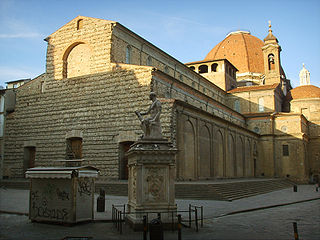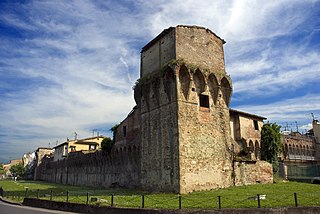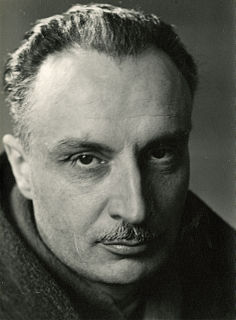
Renaissance architecture is the European architecture of the period between the early 14th and early 16th centuries in different regions, demonstrating a conscious revival and development of certain elements of ancient Greek and Roman thought and material culture. Stylistically, Renaissance architecture followed Gothic architecture and was succeeded by Baroque architecture. Developed first in Florence, with Filippo Brunelleschi as one of its innovators, the Renaissance style quickly spread to other Italian cities. In particular Venetian Renaissance architecture had a very distinct character. The style was carried to France, Germany, England, Russia and other parts of Europe at different dates and with varying degrees of impact.

Florence Cathedral, formally the Cattedrale di Santa Maria del Fiore, is the cathedral of Florence, Italy. It was begun in 1296 in the Gothic style to a design of Arnolfo di Cambio and was structurally completed by 1436, with the dome designed by Filippo Brunelleschi. The exterior of the basilica is faced with polychrome marble panels in various shades of green and pink, bordered by white, and has an elaborate 19th-century Gothic Revival façade by Emilio De Fabris.

The Basilica di San Lorenzo is one of the largest churches of Florence, Italy, situated at the centre of the city’s main market district, and the burial place of all the principal members of the Medici family from Cosimo il Vecchio to Cosimo III. It is one of several churches that claim to be the oldest in Florence; when it was consecrated in 393 it stood outside the city walls. For three hundred years it was the city's cathedral before the official seat of the bishop was transferred to Santa Reparata. San Lorenzo was also the parish church of the Medici family. In 1419, Giovanni di Bicci de' Medici offered to finance a new church to replace the 11th-century Romanesque rebuilding. Filippo Brunelleschi, the leading Renaissance architect of the first half of the 15th century, was commissioned to design it, but the building, with alterations, was not completed until after his death. The church is part of a larger monastic complex that contains other important architectural and artistic works: the Old Sacristy by Brunelleschi, with interior decoration and sculpture by Donatello; the Laurentian Library by Michelangelo; the New Sacristy based on Michelangelo's designs; and the Medici Chapels by Matteo Nigetti.

Michelozzo di Bartolomeo Michelozzi (1396–1472) was an Italian architect and sculptor. Considered one of the great pioneers of architecture during the Renaissance, Michelozzo was a favored Medici architect who was extensively employed by Cosimo de' Medici. He was a pupil of Lorenzo Ghiberti in his early years and later collaborated with Donatello.

Giuliano da Sangallo was an Italian sculptor, architect and military engineer active during the Italian Renaissance. He is known primarily for being the favored architect of Lorenzo de' Medici, his patron. In this role, Giuliano designed a villa for Lorenzo as well as a monastery for Augustinians and a church where a miracle was said to have taken place. Additionally, Giuliano was commissioned to build multiple structures for Pope Julius II and Pope Leo X. Leon Battista Alberti and Filippo Brunelleschi heavily influenced Sangallo and in turn, he influenced other important Renaissance figures such as Raphael, Leonardo da Vinci, his brother Antonio da Sangallo the Elder, and his sons, Antonio da Sangallo the Younger and Francesco da Sangallo.

The Pazzi Chapel is a chapel located in the "first cloister" on the southern flank of the Basilica di Santa Croce in Florence, Italy. Commonly credited to Filippo Brunelleschi, it is considered to be one of the masterpieces of Renaissance architecture.

The Palazzo Medici, also called the Palazzo Medici Riccardi after the later family that acquired and expanded it, is a Renaissance palace located in Florence, Italy. It is the seat of the Metropolitan City of Florence and a museum.
Luca Fancelli was an Italian architect and sculptor.

Antonio Manetti was an Italian mathematician and architect from Florence. He was also the biographer of the architect Filippo Brunelleschi.

San Jacopo sopr'Arno is a church in Florence, Italy.

Lastra a Signa is a comune (municipality) in the metropolitan city of Florence in the Italian region Tuscany, located about 12 kilometres (7 mi) west of Florence.

San Pietro in Gessate is a church in Milan, northern Italy. Built in the 15th century, it is a noteworthy example of Gothic architecture.

The Ospedale degli Innocenti is a historic building in Florence, Italy. It was designed by Filippo Brunelleschi, who received the commission in 1419 from the Arte della Seta. It was originally a children's orphanage. It is regarded as a notable example of early Italian Renaissance architecture. The hospital, which features a nine bay loggia facing the Piazza SS. Annunziata, was built and managed by the "Arte della Seta" or Silk Guild of Florence. That guild was one of the wealthiest in the city and, like most guilds, took upon itself philanthropic duties.

Santa Maria degli Angeli is the former church of a now-defunct monastery of that name in Florence, Italy. It belonged to the Camaldolese congregation, which was a reformed branch of the Benedictines. The congregation is based on the hermitage which was founded in 1012 by the hermit St. Romuald at Camaldoli, near Arezzo, hence the name. Very little of the medieval building exists today.

Italy has a very broad and diverse architectural style, which cannot be simply classified by period or region, due to Italy's division into several city-states until 1861. However, this has created a highly diverse and eclectic range in architectural designs. Italy is known for its considerable architectural achievements, such as the construction of arches, domes and similar structure during ancient Rome, the founding of the Renaissance architectural movement in the late-14th to 16th century, and being the homeland of Palladianism, a style of construction which inspired movements such as that of Neoclassical architecture, and influenced the designs which noblemen built their country houses all over the world, notably in the United Kingdom, Australia and the United States of America during the late-17th to early 20th centuries. Several of the finest works in Western architecture, such as the Colosseum, the Duomo of Milan, the Mole Antonelliana in Turin, Florence cathedral and the building designs of Venice are found in Italy. Italy has an estimated total of 100,000 monuments of all varieties. Now Italy is in the forefront of modernist and sustainable design with Architects like Renzo Piano and Carlo Mollino.
Giovanni di Lapo Ghini was a 14th-century Italian architect working in Florence. He was one of the architects who contributed to the completion of the basilica of Saint Maria of Fiore in the city. His contribution to the cathedral followed the death of the architect Giotto in 1337, and the subsequent dismissal of Francesco Talenti in 1364. However Lapo Ghini was not responsible for the dome which was begun about 1420 by Brunelleschi.

Paolo Monti was an Italian photographer, considered to be one of Italy's greatest. He is known for his architectural photography.
















